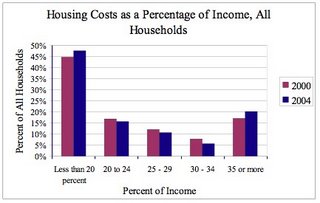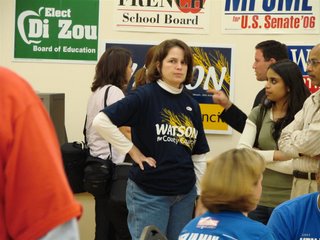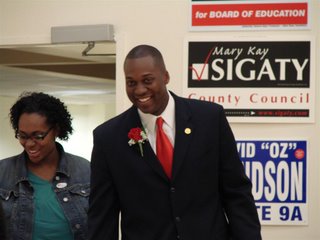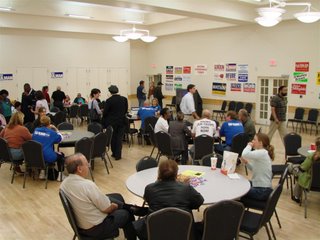Since I led what I thought was a good discussion Tuesday at the Howard County Tomorrow meeting on green infrastructure, I figured this would be as good a topic as any to start with. It doesn't hurt that "greening" the county is also the subject of a couple stories in the local papers.
The foundation for the idea of green infrastructure is similar to that of our "gray" or built infrastructure -- namely, that a comprehensive, interconnected and well-planned network of facilities (open spaces, in the case of green infrastructure) is the best way to ensure the entire system functions effectively and provides the highest return on our investments. Also like gray infrastructure, green infrastructure can be costly, especially in areas where land values and development pressures are high, like Howard County.
Just as we expect our roads to connect and our water and sewer systems to be built with adequate capacity to meet our needs, our system of green spaces should also connect and should also have the capacity to ensure healthy, functioning ecosystems. Or, according to The Conservation Fund:
"Green Infrastructure is the Nation's natural life support system – a strategically planned and managed network of wilderness, parks, greenways, conservation easements, and working lands with conservation value that supports native species, maintains natural ecological process, sustains air and water resources, and contributes to the health and quality of life for America's communities and people."
The Conservation Fund also provides a set of
guiding principles that are worth a read.
The benefits provided by land preservation are many. In addition to fulfilling our
innate desire to be near and a part of nature, open space offers opportunities for recreation, reflection and exploration. Plus, as
numerous studies have shown, living near protected open space greatly increases the value of your property. But, it’s not just about us.
Strong green infrastructure systems are simply better at doing everything nature is supposed to do: filtering air and water, providing habitat for plants and animals (some of which can only live here), and enriching soils, among other functions.
As alluded to earlier, green infrastructure networks are accomplished by setting aside large(ish) areas of land where ecosystems and habitats can be protected, and connecting these areas by a series of green links. Often, these links follow stream corridors, but in order for them to accomplish the intended results, linkages must meet certain criteria, depending on the types of ecosystems and habitats they're connecting. Which is similar to gray infrastructure in that the facilities (water treatment plants, power plants, etc) and connectors (pipes, power lines) must have the sufficient capacity to perform and link to our homes the services that underlay our existence.
Where green and gray infrastructure differ substantially, however, is how they are planned for and how these plans are implemented.
Gray infrastructure -- including water and sewer systems, roads and even schools -- is the source of considerable attention and oversight. Laws are in place to ensure adequate capacity before additional development is permitted, and funding for these systems is usually from dedicated, dependable sources.
Similar to land development in general, land preservation and conservation efforts, in their most prevalant current form, are conducted in an ad hoc, haphazard and unplanned manner. Rather than looking at acquisitions and easements in a broader context, investigating how a parcel will fit within and contribute to the overall strength of the existing green network, expenditures are made based on short-term needs, often because of political or economic expediency.
Moreover, funding for green infrastructure is often subject to political and economic whims, to say nothing of the fact that compared to gray infrastructure funding, it amounts to pocket change. For an example of this, look at Maryland's
GreenPrint program, which sought to implement a state-wide, green infrastructure approach to land preservation. Although it produced
several great maps, including the one below, the program has been
sitting fallow for the last few years. (During my eight-month tenure with the Department of Natural Resources, I worked in this department, which is staffed, basically, by a single person.)
Although much of this is relevant to Howard County, the truth is that our government, more enlightened than many others, is well-aware of the need for connected and vibrant ecosystems. Both the
General Plan 2000 and the
2005 Land Preservation, Recreation and Parks Plan recognize the importance of a green infrastructure system. However, recognition does not equal action, and the action items spelled out in these plans leave much to be desired.
Making green infrastructure hard to plan for is its complexity. Rather than simply a network of undisturbed natural areas, green infrastructure is composed of areas for recreation, managed conservation, agriculture and preservation. The nature of government programs, naturally, is to divide these different areas into different silos within the bureaucracy, which results in uncoordinated efforts and inefficiencies. Case in point, the General Plan has separate chapters on
Preservation of the Rural West and
Working With Nature (both PDFs), and though there are clear differences between the two on one level, one another, they're quite similar.
Montgomery County recognizes this. Despite having plans and programs for agricultural preservation, parks and other open spaces, it is in the process of developing a
green infrastructure plan that will integrate these, and importantly, coordinate various efforts to ensure the best possible outcomes.
Another benefit of Montgomery's plan is that it will create specific implementation goals and measures of success. Howard County's land preservation plan, on the other hand, lacks the regulatory teeth required to make green infrastructure a priority, let alone a reality. Noticeably lacking are specific benchmarks and targets that make action compulsory, not just advisable. The closest we come in Howard County are vague goals like "ensure the environmental integrity of rivers, steams and wetlands", "meet County-wide green space needs" and "remain committed to the State's Green Infrastructure concept and using selective easements and fee-simple acquisitions to further this initiative, where appropriate."
At least, as can be seen in this map, Howard County has a decent start on its green infrastructure network. Although in many cases the linkages are too narrow and the hubs are too small or nonexistent, when developing Columbia, Jim Rouse had the foresight to fill in the "negative spaces" (in artists' terms) first and place development outside of these areas, which is as it should be. Development is subject to the capacity and placement of our gray infrastructure, and green infrastructure should be given the same weight.
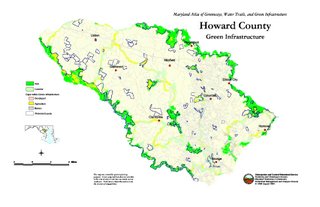
Unfortunately, development is already so prevalent in the eastern part of the county that filling in the negative space first is impossible. We are thus left having to go back after the fact and make room for it. This is both difficult and expensive, making the prioritization of preservation a green infrastructure approach affords that much more important. In addition to finding areas where the natural network can be expanded, we need to look for places where our existing open space can be improved to restore ecosystem strength. The county is already doing this to some extent with a
series of watershed management and restoration plans.
Another way to improve our process is to better integrate all land preservation programs. As part of the General Plan, the county is working on an inventory of environmental areas. In addition inventorying preserved lands, we should rank unprotected areas of ecological value and use these rankings to better target acquisition and easements. Some areas are more valuable than others, and our open space and agricultural preservation funds should reflect this (they already do, to an extent).
Finally, green infrastructure should be tied to development in the same way its gray counterpart is: create real benchmarks, cutoffs, a monitoring system and dedicated funding sources, both public and private.
Healthy green infrastructure isn't just about appeasing environmental sensibilities; it is a recognition of the fundamental role ecosystems play in our economic and social systems and the importance of intelligent and efficient investments open space preservation.





